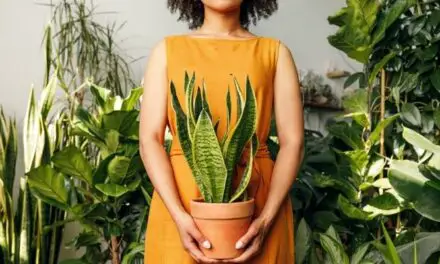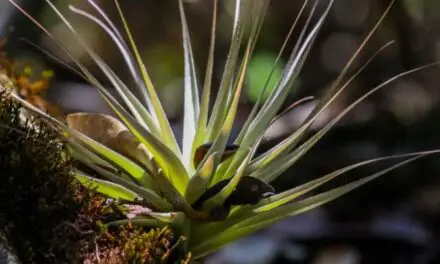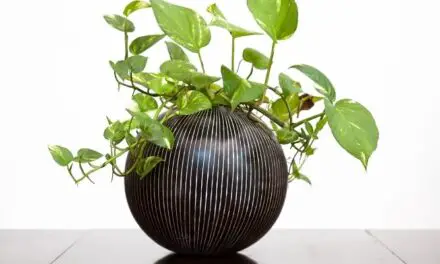You place a plant at a sunny window and after a while, you notice that most of its growth is heading towards either the left or the right side.
This is something that happens a lot (especially with sun-loving succulents).
In this article, we’ll discuss the reasons why plants grow sideways and the things you can do to get them growing straight again.
Table of Contents
Why Is My Plant Growing Sideways?

Your plant is growing sideways because it is not receiving enough light and it is trying to stretch and grow towards the light source.
When there is a light source but a plant is not receiving enough even light exposure, a process called phototropism takes place.
During phototropism, some parts of a plant will grow more than other parts.
The plant does this in an attempt to reach more light so that it can photosynthesize more.
Plants are quick to put energy into reaching light because it is needed for photosynthesis which is crucial for its survival.
It allows the plant to make more food, continue growing, and reproduce.
Is It Bad For A Plant To Grow Sideways?
Yes, it is bad for a plant to grow sideways because it often leads to elongated growth and the plant’s structure becoming weakened and more at risk of damage from disease, pests, rot, wind and even breaking under its own weight.
When a plant grows sideways or stretches for light, it grows thinner, away from its center of gravity, and becomes less stable and more susceptible to breaking under the force of the wind or its own weight.
Growing sideways and elongated also makes a plant less able to stand up to common pests, diseases, and rot.
This is because the plant’s stems grow skinnier and can withstand less damage due to the reduced mass.
Related Article: Why Is My Plant Making Noise? (All You Need To Know)
How To Stop Your Plants From Growing Sideways
The biggest driving factor of your plant growing sideways will be lack of sunlight or uneven sunlight exposure.
Give Your Plant Enough Even Sunlight Exposure
Plants need sunlight to thrive, and without it, they cannot photosynthesize and produce the food they need to grow and reproduce.
Photosynthesis allows the plant to produce glucose, which is essential for a plant to survive.
Plants will always put their energy into the thing that will most likely lead to their survival.
In this case, the plant will put its energy into reaching the light because it knows there is a source of light and it also knows that it is not receiving enough light to grow properly.
Uneven Light Exposure
Some sun-loving plants – especially succulents – may start to grow sideways even if you put them at a sunny window.
This usually happens when you do not rotate the plant so that it receives an even amount of sunlight.
Rotate your plant once every few days just to make sure it’s getting an even amount of sunlight and less likely to start reaching.
How much sun?
You’ll need to research the amount of light your specific plant species needs.
Some plants need lots of direct sun and others like a lesser amount of indirect sunlight.
But all plants like to have the light that they require dispersed upon them evenly.
That’s why it’s often a good idea to rotate plants that are sitting at a sunny window.
As a general rule, the average plants tend to need approximately 12 to 15 hours of sunlight, but only 5-6 of those hours should be direct sunlight.
Other plants need significantly less, but if your plants are growing sideways, it could be a clear sign that they need more sun than they are currently receiving.
Apart from uneven sunlight, some less common factors can cause or contribute to a plant growing sideways.
Pot Your Plant In Suitable Soil?
Lack of sunlight will almost always be the primary reason for a plant growing sideways.
But poor soil conditions can make the problem worse.
Poor soil conditions or soil erosion can also contribute to a plant that won’t grow straight.
Erosion is more likely to happen over time and it is a big problem in areas where it rains frequently.
Erosion in the soil could prevent your plant from getting the nutrition it needs to stay healthy, and it could also cause the roots to grow less deep – making the plant unstable.
Erosion issues can occur both in the soil outside and in pots.
It is worth checking the soil as poor soil quality or erosion can cause of contributing to your plant growing sideways.
Be Careful Not To Over-Fertilize
Although less common over-fertilization can also contribute to a plant growing sideways.
Fertilizer can be great when it comes to promoting growth and plant health, but too much of anything can be bad.
If you over-fertilize your plants, you could end up with too much nitrogen in the soil, which could end up promoting the growth of longer stems instead of thicker and stronger stems, which is its original purpose.
If the problem is determined to be in the soil, you may have to transplant the plant to new soil, to get rid of both erosion and potential over-fertilization.
Your Plant May Need Support
Some plants naturally grow long and thin.
This can cause the plant to struggle under its own weight and begin to grow sideways.
There are a few plant types that are ofter going to require support as they get big or at the beginning of their growth spurt.
Failing to provide these plants with structural support can easily cause them to grow abnormally or even fold over on themselves.
If you have young plants with skinny stems that require support – stake them right away to help them grow straight and tall.
How To Prevent Your Plant From Growing Sideways
To keep your plant growing straight, you’ll have to ensure it’s receiving the right amount of even sunlight and that it’s supported with the correct soil type and a stake, if necessary.
It’s good to consider how exactly your plant will grow before it gets too big.
A plant that has already stretched out in one direction can be problematic to support, but there are a few things you can do when you initially bring the plant home.
Start by placing the plant in a location where it will receive enough natural light.
Not all plants like direct sunlight, but, depending on your plant’s species, some degree of natural light will be essential for healthy growth.
After placing it in its location, keep an eye on your plant to make sure it is getting as much light as it needs.
Next, make sure the soil is fresh and as it should be.
Before planting it is your opportunity to set your plant up for success, and you want to get it right.
Proper support is also something you can plan for if you know you are getting a plant that usually isn’t able to stand on its own in the beginning.
This does not apply to plants that have already grown too tall and skinny or plants that are already leaning.
How To Fix A Plant That Is Growing Sideways
If your plant is not growing straight and leaning towards the light, try rotating the plant or moving it to a location with light that falls more evenly on it.
You can also check the soil to make sure it’s appropriate and doing a good job of supporting the plant’s roots.
If the plant has grown too tall and its stems cannot support it, you’ll have to put a bamboo stake in the soil and use string to tie the stake to it for support.
Final Thoughts
A plant that is growing sideways doesn’t look great, it takes up unnecessary space and it could potentially be harmful to the plant’s leaves and stem.
But once you know the common causes of this, it’s fairly easy to spot and do something about early on so that your plant can soon get back to growing straight again.




